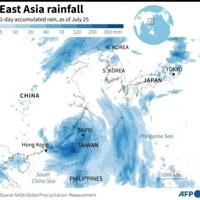With Typhoon Gaemi causing havoc across eastern China, nearly 300,000 people have been evacuated and public transport has been suspended. The typhoon has already led to five deaths in Taiwan, where it was the strongest to hit the country in eight years, causing flooding in the second-largest city.
Before reaching Taiwan, Gaemi had already affected the Philippines, resulting in 20 deaths from flooding and landslides. A tanker carrying 1.4 million litres of oil also sank off Manila, causing a fuel spill.
Although it weakened upon reaching eastern China’s Fujian province, Gaemi was still expected to bring heavy rains. This comes as the country experiences extreme weather conditions this summer, with heavy rains in the east and south contrasting with heatwaves in the north.
China, as the world’s largest emitter of greenhouse gases, is facing the consequences of climate change in the form of more frequent and intense extreme weather events.
– Heavy rains –
Authorities in China are warning of potential flood risks due to Gaemi’s heavy rains. More than 290,000 people have been relocated in Fujian, and public services have been shut down in several cities.
In Zhejiang province, footage shows the aftermath of the typhoon, with streets flooded, trees blocking roads, and people wading through knee-high water. Wenzhou city has evacuated nearly 7,000 people and issued a high rainstorm warning.
The typhoon is expected to bring heavy rainfall to Jiangxi and Henan provinces as well. Guangdong province has suspended some train services in anticipation of the storm’s arrival.
Despite the disruptions, no deaths or injuries have been reported so far. Meanwhile, heavy rains in northwest Gansu province have resulted in one death and three people missing.
At a leadership meeting chaired by President Xi Jinping, officials stressed the need for vigilance and proactive measures, particularly as the country enters peak flooding season.





